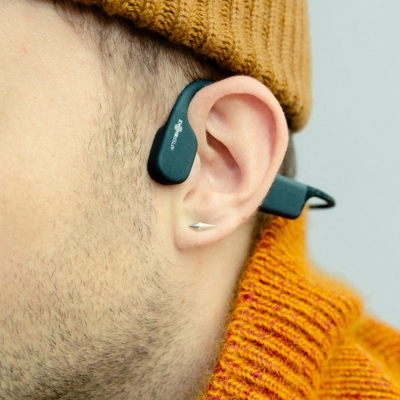What Are Open-Ear Headphones? Everything You Need to Know
Have you ever found yourself so lost in your music that pausing it to have to talk to somebody or stay alert to your surroundings completely ruins the moment? Traditional in-ear headphones are great for immersive listening, but they often come at the cost of comfort and awareness, so they’re not ideal for some.
That’s where open-ear headphones step in. Designed to keep your ears open to the world, this innovative audio technology lets you enjoy your favourite sounds without tuning everything else out. But what are open-ear headphones, exactly?
Unlike traditional earbuds that seal off your ear canal, open-ear designs sit outside or around your ear, allowing you to stay connected to your surroundings while still enjoying your music or podcast. Whether you’re working, exercising, commuting, or chilling at home, open-ear headphones provide a seamless way to stay present—without ever missing a beat.
Here’s everything you need to know about open-ear technology—and why it’s redefining the way we listen.

What Are Open-Ear Headphones?
Most traditional wireless earbuds use an in-ear design. Think the iPhone Airpods Pro 2 or the Beats Fits Pro, where the earbud fits snugly inside the ear canal and seals it with silicone tips.
This helps block out external noise, offering an immersive listening experience. But it also isolates you from your surroundings, which isn’t ideal in many real-world scenarios.
Open-ear headphones take a different approach. Rather than sealing off your ears, they sit just outside or around the ear, allowing external sounds to come through naturally. This design offers a more open and comfortable experience, making it easier to stay aware of your environment while still enjoying high-quality audio.
There are two primary ways open-ear headphones transmit sound:
Bone Conduction Technology

Bone conduction bypasses the eardrum entirely, and while these devices are commonly referred to as headphones, they don’t technically fall into that category. Instead of using speakers to create sound waves, they transmit vibrations through the bones of your skull directly to your inner ear.
The result? You “hear” the audio without anything blocking your ear canal. This makes bone conduction especially popular among runners, cyclists, and anyone who needs to stay alert to their surroundings.
Bone conduction often comes with a compromise in audio quality. Since it transmits vibrations rather than traditional sound waves, the range and depth of sound—especially bass tones—can be limited. Also, for the best experience, the headphones need to press firmly against your head, which can be uncomfortable for some.
Pros:
- Nothing goes in your ear
- Great for outdoor activities like running or cycling
- You stay fully aware of your surroundings
Cons:
- Audio quality (especially bass) can be limited
- Needs to press against your head, which some find uncomfortable
Air Conduction Technology

In contrast, air conduction relies on the natural path of sound—airwaves traveling into the ear. With this design, the headphones hover just outside the ear canal and project sound toward it. Since nothing is physically sealing the ear, you can still hear what’s going on around you.
Recent advances in air conduction technology have significantly improved the listening experience. High-fidelity drivers and precise audio direction allow users to enjoy full-range sound—from clear dialogue to deep bass—without leaking noise into the surrounding environment.
Pros:
- More natural, refined sound
- Better bass and detail compared to bone conduction
- No ear blockage, yet immersive audio
- Comfortable for long periods
Cons:
- Some sound leakage possible
- May feel less secure during intense movement
Why Choose Open-Ear Headphones?
Open-ear headphones are much more than just staying aware of your surroundings. They’re also designed for comfort and practicality. Some In-ear models can become uncomfortable after long periods. Open-ear designs offer a lighter, less intrusive feel that many people can wear all day without discomfort.
Here are some key benefits to open-ear headphones:
- All-day comfort: With no need to insert anything into the ear canal, open-ear designs reduce pressure and irritation, even during extended wear.
- Environmental awareness: Perfect for busy settings. Whether you’re at the office, out for a run, or on public transport—you’ll always be able to hear what’s going on around you, although this isn’t always a good thing.
- Improved safety: By allowing ambient noise through, open-ear headphones are ideal for outdoor activities where situational awareness is crucial.
- Social ease: You don’t have to remove your earbuds to have a quick chat, take a call, or respond to a coworker.
A New Standard for Personal Audio
So what are open-ear headphones? They’re more than just a niche alternative—they represent a shift in how we approach personal audio. With sleek, lightweight designs and advanced sound technology, they strike a balance between immersion and openness.

Many models, such as the Bose Ultra Open Earbuds or the Cleer ARC 3 – Dolby Atmos Open-Ear Earbuds feature stylish ear-hook or the ear-cuff shapes that stay secure while remaining barely noticeable, making them ideal for both active and casual use.
Battery performance has also improved. Open-ear headphones now boast several hours of playback on a single charge, with additional hours available through portable charging cases. Some models even include smart features like adaptive volume control, spatial audio, and multi-device syncing.
What Are Open-Ear Headphones, and Why Do They Matter?
If you’ve ever wondered what open-ear headphones are and whether they’re worth considering, the answer lies in how they balance sound and awareness. These innovative headphones offer a way to stay immersed in your music while remaining open to the world around you—no pausing, no unplugging, no disconnection.
Whether you’re commuting, working, exercising, or simply moving through your day, open-ear headphones provide a seamless listening experience that doesn’t isolate you. And with ongoing advancements in comfort, design, and sound quality, they’re quickly becoming a go-to option for people who want to stay both connected and present.

I am a passionate and skilled car audio enthusiast with 15 years of experience in the industry. My journey started when I replaced my first set of factory car speakers, sparking a deep love for high-quality sound. Since then, I have worked as a representative for renowned brands like Kenwood and Alpine.
With a background in both retail and distribution, I have developed a comprehensive understanding of the car audio market. Currently a certified (MECP) installer in the Mobile Electronics industry, my expertise lies in delivering top-notch audio installations. My knowledge, coupled with my genuine passion, makes me the go-to professional for all car audio needs.
